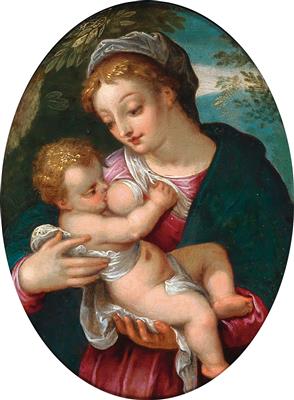Hans Rottenhammer

(Munich 1564–1625 Augsburg)
The Virgin nursing the Christ Child,
oil on copper, 21.5 x 16 cm, framed
We are grateful to Luuk Pijl for suggesting the attribution (written certificate).
Rottenhammer was, alongside Adam Elsheimer, arguably the most celebrated of the German painters active in Italy at the turn of the seventeenth century. The present rediscovered, charming small copper panel may be the long-lost prototype for a number of copies and derivations by the studio or anonymous followers, that are of decidedly inferior quality (for example, the painting sold at Nagel, Stuttgart, February 2008, lot 669).
Rottenhammer painted the Virgin and Child on a copper panel, a medium which’s enamel-like quality was prized by collectors. The composition and style are strongly influenced by Venetian sixteenth century painting, most notably by Tintoretto. Scholars have long positioned Rottenhammer’s paintings on copper as objects of cultural transmission, in which the Venetian style was transposed to precious cabinet paintings for collections in Germany and Northern Europe. The present painting would appear to be an excellent example of such a small cabinet painting, intended for private devotion or, more likely, for a Wunderkammer in Northern Europe.
Hans Rottenhammer was one of the many Northern European artists who crossed the Alps after his apprenticeship in order to gain further education. Best known for his paintings of religious themes on copper panels, the Munich-born Rottenhammer not only acquired the styles and motifs of Italian masters but also developed a successful marketing network as he constructed an international career from Venice through the use of artist-friends and the German and Flemish merchant community. Unlike many of his contemporaries who stayed for one to two years before returning home, Rottenhammer remained in Italy for about seventeen years, from 1589 to 1606. During this period, he opened a successful workshop in Venice, gained a reputation for small-format cabinet paintings on copper panels such as the present, and married a Venetian woman named Elisabetta de’ Fabris. Rottenhammer’s production of copper paintings occurred primarily in Rome and Venice, so it would appear plausible to date the present painting before his departure for Augsburg in 1606.
Esperto: Dr. Alexander Strasoldo
 Dr. Alexander Strasoldo
Dr. Alexander Strasoldo
+43 1 515 60 403
oldmasters@dorotheum.com
10.11.2020 - 16:00
- Prezzo realizzato: **
-
EUR 6.475,-
- Stima:
-
EUR 8.000,- a EUR 10.000,-
Hans Rottenhammer
(Munich 1564–1625 Augsburg)
The Virgin nursing the Christ Child,
oil on copper, 21.5 x 16 cm, framed
We are grateful to Luuk Pijl for suggesting the attribution (written certificate).
Rottenhammer was, alongside Adam Elsheimer, arguably the most celebrated of the German painters active in Italy at the turn of the seventeenth century. The present rediscovered, charming small copper panel may be the long-lost prototype for a number of copies and derivations by the studio or anonymous followers, that are of decidedly inferior quality (for example, the painting sold at Nagel, Stuttgart, February 2008, lot 669).
Rottenhammer painted the Virgin and Child on a copper panel, a medium which’s enamel-like quality was prized by collectors. The composition and style are strongly influenced by Venetian sixteenth century painting, most notably by Tintoretto. Scholars have long positioned Rottenhammer’s paintings on copper as objects of cultural transmission, in which the Venetian style was transposed to precious cabinet paintings for collections in Germany and Northern Europe. The present painting would appear to be an excellent example of such a small cabinet painting, intended for private devotion or, more likely, for a Wunderkammer in Northern Europe.
Hans Rottenhammer was one of the many Northern European artists who crossed the Alps after his apprenticeship in order to gain further education. Best known for his paintings of religious themes on copper panels, the Munich-born Rottenhammer not only acquired the styles and motifs of Italian masters but also developed a successful marketing network as he constructed an international career from Venice through the use of artist-friends and the German and Flemish merchant community. Unlike many of his contemporaries who stayed for one to two years before returning home, Rottenhammer remained in Italy for about seventeen years, from 1589 to 1606. During this period, he opened a successful workshop in Venice, gained a reputation for small-format cabinet paintings on copper panels such as the present, and married a Venetian woman named Elisabetta de’ Fabris. Rottenhammer’s production of copper paintings occurred primarily in Rome and Venice, so it would appear plausible to date the present painting before his departure for Augsburg in 1606.
Esperto: Dr. Alexander Strasoldo
 Dr. Alexander Strasoldo
Dr. Alexander Strasoldo
+43 1 515 60 403
oldmasters@dorotheum.com
|
Hotline dell'acquirente
lun-ven: 10.00 - 17.00
old.masters@dorotheum.at +43 1 515 60 403 |
| Asta: | Dipinti antichi |
| Tipo d'asta: | Asta in sala con Live Bidding |
| Data: | 10.11.2020 - 16:00 |
| Luogo dell'asta: | Wien | Palais Dorotheum |
| Esposizione: | 04.11. - 10.11.2020 |
** Prezzo d'acquisto comprensivo di tassa di vendita e IVA(Paese di consegna Austria)
Non è più possibile effettuare un ordine di acquisto su Internet. L'asta è in preparazione o è già stata eseguita.
